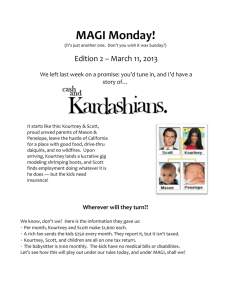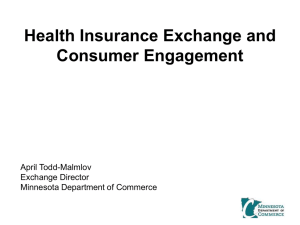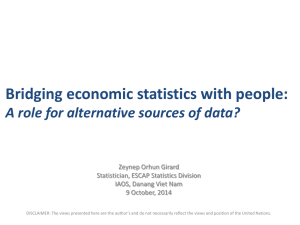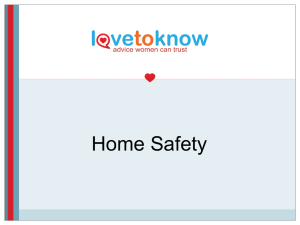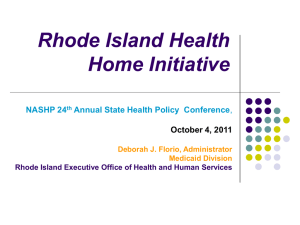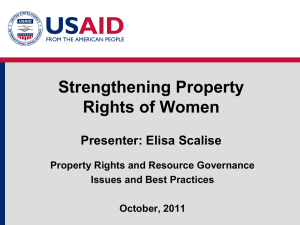Medicaid Expansion & MAGI Budgeting
advertisement
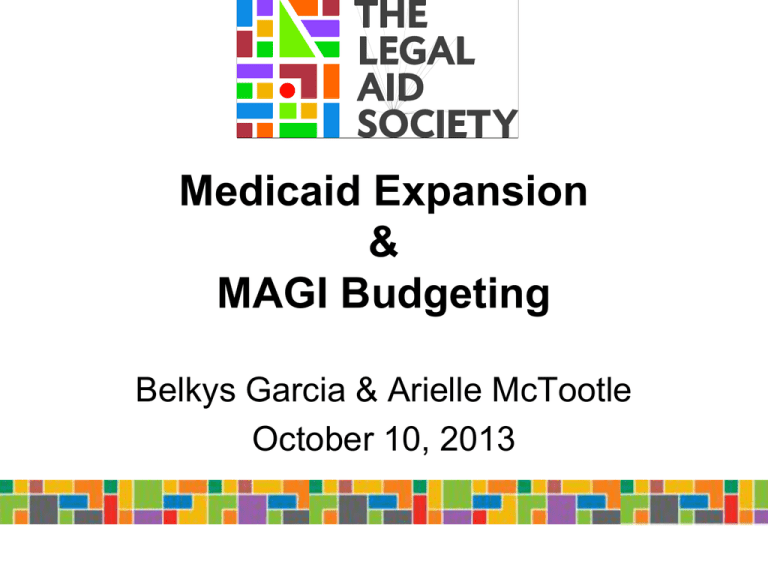
Medicaid Expansion & MAGI Budgeting Belkys Garcia & Arielle McTootle October 10, 2013 Today’s Agenda • • • • • Background New categories of eligibility 5 aspects of eligibility – what’s changed? Applications and enrollment Issues to watch Background Goal of the Patient Protection Affordable Care Act (ACA) is to provide all Americans with quality, affordable health insurance 1. 2. 3. 4. 5. Expand Medicaid Individual and Employer Requirements Insurance Reforms Health Insurance Exchange Federal Tax Subsidies Medicaid Expansion For States that opt-in, the ACA expands Medicaid coverage to a new eligibility population that includes single adults, up to 138% of the federal poverty level (FPL). 42 U.S.C. § 1396a(a)(7); 42 C.F.R. § 435; N.Y. Soc. Serv. § L. 336 Timeline • October 1, 2013 – MAGI population can apply for Medicaid through the New York State of Health & receive eligibility determinations using new MAGI rules, but coverage through Medicaid Managed Care plans will not begin until January. – Individuals can shop for QHPs on the exchange. • December 31, 2013 – No new FHP applications will be taken. • January 1, 2014 – Coverage begins for PHI and QHPs. • April 1, 2014 – New MAGI budgeting applies upon renewal for all MA recipients. New Eligibility Categories MAGI • • • • Pregnant women Children under 19 Parents/caretaker relatives Childless adults: Non-MAGI • • • – Not pregnant – 19 – 65 • • 19 & 20 year olds living with parents Child in foster care (Chaffee) • • • Age 65 or older; Certified disabled TANF, SSI, Foster Care children, adopted child receiving medical subsidy, child for whom kinship or guardianship assistance payments are made Spend down, LTC needs, MBI, MSP, cobra continuation, Pickle Cancer programs, Former Foster Care, waiver programs Residents in adult homes, treatment centers, OMH facilities 42 U.S.C. § 1396a(a)(10)(VIII); 42 C.F.R. § 435.603(j); N.Y. SSL § 366(b) Can Choose MAGI or nonMAGI • Certified disabled, but not yet receiving Medicare. • Parent/caretaker relatives, even if they are disabled and/or over 65, and start receiving Medicare. • Disabled children, unless they are in a waiver program. Five Eligibility Criteria 1. 2. 3. 4. 5. Residency Immigration Status Category Income Resources 1. Residency Old Rule = Must be a New York Resident to receive Medicaid in New York. N.Y. Soc. Serv. L. § 366-a • Resident = intend to remain in New York “permanently or indefinitely.” 42 C.F.R. § 435.403 New Rule = NO CHANGE. Must be a New York Resident to receive Medicaid in New York. N.Y. Soc. Serv. L. § 366-a • Resident = intend to remain in New York “permanently or indefinitely.” 42 C.F.R. § 435.403 2. Immigration Status Old rule = qualified immigrant including PRUCOL. Undocumented immigrants eligible for emergency MA. New rule = NO CHANGE. PRUCOL immigrants still eligible for MA. Undocumented immigrants eligible for emergency MA. – As of January 2014, undocumented immigrants can apply for emergency Medicaid through the Exchange NYSSL 122[1](c); Aliessa, et al. v. Novello (96 N.Y. 2d 418); 8 USCA 1611(b)(1)(A); 1621. 3. Category Old Rule = various categories depending on age, disability status, living with children, etc. New rule = 4 categories 1. 2. 3. 4. Pregnant women Children Parents/caretaker relatives Childless adults 1. 42 CFR §435.116; 2. 42 CFR §435.118; 3. 42 CFR §435.110. 4. 42 CFR §435.119 Category (cont’d): Household Size • MAGI household is the IRS filing unit • Exceptions for children: – Children living with relatives who are not their parents; – Children living with both parents, although the parents file separately; – Children claimed as dependents by non-custodial parents. • Pregnant women counted as self + number of expected children • Married spouses living together are in each other’s household, regardless of whether they file jointly or separately. 42 CFR 435.603(d); 42 CFR 435.603(b); 42 CFR 435.603(f) Category (cont’d): Household Size If an individual is claimed as a tax dependent and not the spouse or child of the taxpayer OR If an individual is not expected to file tax return and not claimed as dependent in that year, The household size would include: • Self, spouse, and children less than 19 years old (or, if full-time student, less than 21 years old) 42 C.F.R. 436.603(f) Household Case Example # 1 James (the taxpayer) and Alexis (James’s wife) live together with two minor children, John and Susan, as well as James’s Aunt Patricia (who does not file taxes). James claims all of them as dependents. Household Case Example Q. What is James’ household size? A. James’ household size is five. His household includes James plus his four dependents. Household Case Example Q. What is the household size of the dependents? A1. As long as Alexis and James are filing jointly, the household size for Alexis, John and Susan (dependents) is five, the same as James (taxpayer). Household Case Example (cont’d) A2. Aunt Patricia’s household is a household of one because Aunt Patricia has no parents, spouse or siblings living in the same household. Household Case Example #2 James and Alexis are separated. Alexis lives with their children, John and Susan. Alexis also lives with her new child, Mary. James claims John and Susan as a dependent on his taxes. Alexis claims Mary as her dependent. Q. What is Alexis’ household size? A. Alexis’ household size is two – Alexis and her tax dependent, Mary. Q. What is James’ household size? A. James is a household of three – James and his two dependents, John and Susan. Q. What is John’s household size? A. John household size is four – John, Susan, Alexis and Mary. Q. What is Susan’s household size? A. Susan’s household size is four – Susan, John, Alexis and Mary. Q. What is Mary’s household size? A. Mary’s household size is two – Mary and Alexis. 4. Income Old rule = 10 income categories New rule = 5 income categories 1. Pregnant women 42 CFR §435.116 ; N.Y. Soc. Serv. L. §366(1)(b)(2); 2. Infants 42 CFR §435.118; N.Y. Soc. Serv. L. §366(1)(b)(2); 3. Children 42 CFR §435.118; N.Y. Soc. Serv. L. §366(1)(b)(3); 4. Parents 42 CFR §435.110; N.Y. Soc. Serv. L. §366(1)(b)(4); 5. Childless Adults 42 CFR §435.119; N.Y. Soc. Serv. L. §366(1)(b)(1); Income (cont’d) 1. Pregnant women = 223% FPL N.Y. Soc. Serv. L. §366(1)(b)(2) 2. Infants = 223% 3. Children = 154% (with some exceptions) N.Y. Soc. Serv. L. §366(1)(b)(2) N.Y. Soc. Serv. L. NYSSL §366(1)(b)(3) 4. Parents = 138%; 155% = wrap N.Y. Soc. Serv. L. NYSSL §366(1)(b)(4) 5. Childless Adults = 138% N.Y. Soc. Serv. L. §366(1)(b)(1) Family Health Plus (FHP) FHP used to cover parents living with children under 21 and children 19 – 20 years old living with parents, up to 150% FPL. Family Health Plus program will end on January 1, 2014. People with children who are between 138% -150% of FPL will need to enroll in a silver-level plan through the Exchange and will pay NO premiums. N.Y. Soc. Serv. L. § 367-a(3)(e); 2013-14 NEW YORK STATE EXECUTIVE BUDGET Art. VII Part D § 14, 14a, 15, 16. Exceptions to 154% FPL for MAGI-children Children 19 or 20 living with parents will be eligible for MA up to 155% of FPL through September 2019. N.Y. Soc. Serv. L. § 366(a)(9)(b) (7) A child under 21 years of age and who was in foster care under the responsibility of the State on his or her 18th birthday is eligible for Medicaid with no income test. N.Y. Soc. Serv. L. § 366(a)(9)(b)(5) Income (cont’d) MAGI MAGI is Modified Adjusted Gross Income is based on IRS rules. Section 36B(d)(2) of Internal Revenue code of 1986; 42 C.F.R. § 435.603(d); 42 C.F.R. § 435.603(e) Gross Income Gross income = wages, SS income, investment income, unemployment, pensions, IRA distribution, alimony, and income from self-employment, Not Income • Child Support • Income from child or tax dependent who is not expected to be required to file a tax return in the taxable year for which MA eligibility is determined. • Medicaid rules apply to lump sums, and certain educational scholarships and payments to Native Americans. Sec. 36B(d)(2) of IRC of 1986; 42 C.F.R. § 435.603(d); 42 C.F.R. §435.603(e) Self-Employment Income Self employment income is income after expenses claimed on schedule C. Adjustments Adjustments = alimony, moving expenses, student loan interest, and self-employed health insurance contributions Income Disregards Old Rule = Many disregard rules. New Rule = Only 1 disregard: 5% of your Modified Adjusted Gross Income. 133% becomes 138% 42 U.S.C. § 1396a(14)(I)(i); 42 C.F.R. § 435.603(d)(1) 5. Resources Old Rule – No Resource Test New Rule – NO CHANGE. No Resource Test 42 U.S.C. § 1396a(C); 42 C.F.R. § 435.603(g) Eligibility Example Alexis is a single mother with 2 children Susan age 5 and John age 3. Alexis is employed, earning $24,000 a year. She also receives $4,000 per year in child support and pays $3,000 per year for child care. Current Medicaid Rules • • Family size: 3 Income: – Wage $24,000 – Child support $4,000 • • Total Income: $28,000 Deduction: $90 per month for earning, $100 per month for child support, and child care expenses: $5,280 • • Medicaid income: $22,720 FHP income: $28,000 • Children Medicaid Eligible, Mom eligible for Family Health Plus MAGI Rules • • Family size: 3 Total Countable Income: $24,000 • All Three Medicaid eligible Income & Benefit Levels for MAGI Groups Income Levels for MAGI Groups Medicaid Medicaid Benchmark FHP Wrap PTC CHIP 400% 350% 300% 400% 400% 400% 400% 400% % FPL 250% 200% 150% 100% 150% 223% 138% 154% 155% 50% 138% 83% 0% Pregnant Women & Infants Children (ages Children ages 1 - 18) 19 & 20 (living with parents) Parents Childless Adults Courtesy of Empire Justice Center Medicaid Benchmark Benefit • ACA establishes Medicaid Benchmark Benefit for newly eligible MAGI applicants – Medicaid benefit will not be uniform; benchmark benefit is not “full” Medicaid – Benchmark benefit includes all covered Medicaid benefits except long-term care Applications and Enrollment Applications October 1, 2014 – new MAGI Medicaid applicants can apply through the NY State of Health via: • • • • • Online Navigators Certified Application Counselors Brokers By Mail 42 C.F.R. § 435.907(a) Application Timeline • October through December 2013, MAGI applicants will have a two-step process: 1. Receive an eligibility determination, 2. Return in December to pick a plan. • • Coverage will not begin until January 2014. FFS will pick up bills incurred after the eligibility determination and before plan coverage starts. Advocate tip: People should continue to apply through local district until January 1, 2014. • Applications for retro coverage will be forwarded to local districts for old rules & LDSS will follow-up with applicant. In-Person Assistors & Navigators The old “Facilitated Enrollers” have been replaced with “In Person Assistors” and “Navigators,” who counsel applicants and submit applications directly. Verification Data-matching: States must develop secure, electronic interfaces to allow for data-matching and eligibility determinations. States must use datamatching to the maximum extent practicable. Self-attestation: Exchange may accept attestation of information and conduct database verification needed to determine eligibility without further documents. 42 CFR 435.945 Reasonable Compatibility: Standard for assessing whether verification can be considered complete, or if additional information is necessary. When data obtained is “reasonably compatible” with an applicant’s attestation, State agencies are prohibited from requiring additional documentation. 42 C.F.R. 435.952(c) Renewal & Reporting • Renewal – State must use available information to facilitate annual re-determination process. 42 CFR 435.916 • Reporting – Individuals must report changes with respect to eligibility standards through the same modalities they can apply for coverage. 42 CFR 435.916(c) Pop Quiz Bob and Brenda are married. They have two children, Arthur age 2 and Hank age 19. Bob claims Brenda, Arthur and Hank as his dependents. Bob and Brenda’s income is 155% of FPL for a household of four. Arthur works and earns $5,000 per year and isn’t required to file taxes. Brenda’s mother, Beatrice also lives with them. Beatrice is 75 years old. She received $500 per month Social Security Retirement and Medicare. Beatrice does not file taxes. Household size? Bob, Brenda, Arthur and Hank = Household of four Beatrice = Household of one Benefit? Bob and Brenda are eligible for FHP wrap. Arthur is eligible for CHIP. Hank is eligible for full Medicaid. Beatrice gets full Medicaid. Category? Bob and Brenda are MAGI as parents. Arthur is MAGI as a child under 18. Hank is MAGI as a 19 year old living with his parents. Beatrice is non-MAGI. Issues to Watch How is it working? - What data is collected? What notices do applicants receive? How are they dealing with mixed households? How are they treating applicants with sporadic income?



